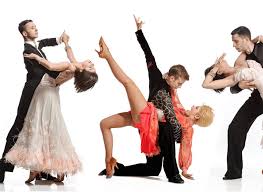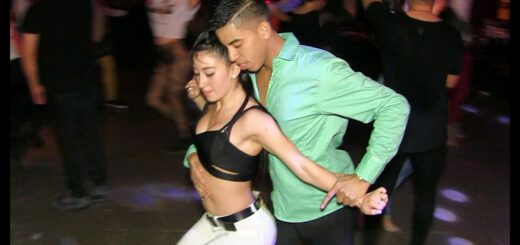Benefits of Social Dancing
Social dancing is a wonderful activity that benefits people of all ages. Whether it be Ballroom, Salsa, Swing, Tango, Hustle… there are many benefits to incorporating dance into your daily life, including fitness, emotional health, social health, and mental health benefits.
1) Dancing is a great FITNESS ACTIVITY. Dancing is an excellent cardiovascular exercise that utilizes many major muscular groups, and encourages proper posture and skeletal alignment. Flexibility, agility, and core strength are also greatly improved as well. Dancing is an enjoyable activity, so you won’t be looking at the clock or pedometer to see how much you worked out. In fact, you’ll notice that at times, time flies by so fast that you wish the dance class or social night out was longer at times. Which means, you will be « working out » longer than perhaps at the gym.
2) Dancing will improve your EMOTIONAL HEALTH. Not only does social dancing require coordination and rhythm, it requires you to move with another person (your partner) through Leading & Following, thereby stimulating the neurological pathways greatly. There are many studies that find that dancing helps reduce stress and increases serotonin levels as well. I truly felt the effect of this a couple days ago myself. I was stressed out and frustrated with some personal matters all morning and afternoon, but after I taught Salsa for 2 hours then practiced the Foxtrot and Quickstep with a friend for another hour, I felt tremendously better emotionally, slept well, woke up the next morning full of energy and was motivated and excited for the day ahead of me.
3) Dancing is a great SOCIAL ACTIVITY. As the name implies, social dancing is meant to be « Social ». Whether it be Ballroom, Salsa, Swing, Tango, Hustle… in dance classes or social dance gatherings, these dances require you to partner-up with someone else, so you will be acquainted with one other person. By going to social dance classes and social dance functions, you will meet people of both genders with a common interest – Dance – and thereby make new friends and acquaintances. If you are new and shy, try group dance classes first. You won’t have the pressure to have to ask someone to dance and most dance classes have you rotate partners throughout the class.
4) Dancing makes you SMARTER. Dancing integrates several brain functions simultaneously, therefore improves connectivity. There have been studies finding that dancing helps prevent Alzheimer’s Disease and Dementia as well. Simply put it, dancing requires you to use your brain differently from your everyday life, thus stimulating and creating new neurological pathways. I recently had the opportunity to teach Ballroom & Swing to adults affected with Parkinson’s Disease. It was definitely a ground-breaking experience. Once these individuals took dance position (held hands with each other) and started dancing to the music, it was as if they did not have such a disease – the awkward trembling and tension was almost non-existent when they were dancing, and not only that, they developed the same muscle memory of dance patterns, just as any of my regular students would by consistent training
So what now? Well, there are dance studios and ballrooms all across the country in most cities, with many wonderful dance instructors teaching group dance classes. So maybe start there. I enjoy dancing all the partner-dances and most ballroom dance studio provide instruction for over 20 styles of social dancing**, but if you don’t click with a dance, it’s OK, try another dance. Just like we all have different tastes for music, it’s the same with dancing. If you like big band music, try swing. If you like the Latin sounds, try salsa or rumba. If you like the blues, try the Foxtrot. Also, remember that once you learn one dance well, it’s going to be easier to learn another dance, so don’t feel like you have to do everything at once.
I must mention at the end, the benefits of dancing feel apparent immediately for some people, but may take some time to feel for others. To develop good social dancing skills will definitely take some time as well. However, I will assure you that if you consistently go after dancing, you will get better and it will become fun.
Now let’s dance!
** Common styles of social dancing:
Social Latin: Salsa, Bachata, Merengue, Cha Cha Cha, Argentine Tango
American Smooth: Waltz, Tango, Foxtrot, Viennese Waltz
American Rhythm: Cha Cha Cha, Rumba, Bolero, East Coast Swing, Mambo
International Standard: Waltz, Tango, Foxtrot, Quickstep, Viennese Waltz
International Latin: Cha Cha Cha, Samba, Rumba, Paso Doble, Jive
Swing: Jitterbug, Lindy Hop, Charleston, Balboa, College Shag, West Coast Swing
Other: Hustle, Night Club Two Step, Country Two-Step
























